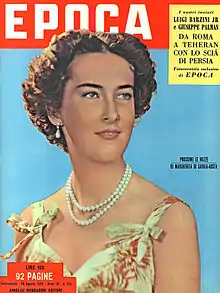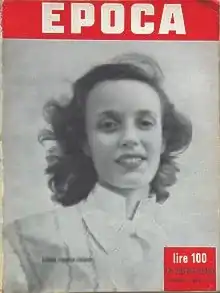Epoca (magazine)
Epoca (Italian: Age) was an Italian illustrated weekly current events magazine published between 1950 and 1997 in Milan, Italy.
 1953 cover featuring Margherita, Archduchess of Austria-Este | |
| Former editors |
|
|---|---|
| Categories | Current affairs magazine |
| Frequency | Weekly |
| Founded | 1950 |
| First issue | 14 October 1950 |
| Final issue | 1997 |
| Company | |
| Country | Italy |
| Based in | Milan |
| Language | Italian |
| ISSN | 0013-9718 |
| OCLC | 1718813 |
| Part of a series on |
| Conservatism in Italy |
|---|
 |
History and profile

Epoca was first published on 14 October 1950.[1][2][3] The magazine was modeled on Life[4][5] and Paris Match.[2] Epoca was the first Italian publication which employed the illustrations like these and other popular magazines of the period such as Look.[6]
The magazine was part of Mondadori[3][7] and was based in Milan.[8][9] Its first editor was Alberto Mondadori who was succeeded in the post by Enzo Biagi in 1953.[2] During the period until 1960 when Enzo Biagi edited Epoca the magazine covered current affairs news, social attitudes as well as TV news.[2] The magazine also included frequent and detailed articles about Hollywood stars of the period[10][11] and Italian movie stars such as Gina Lollobrigida.[12] The weekly had offices in New York City, Paris and Tokyo.[5] From June 1952 to the late 1958 the Cuban-Italian writer Alba de Céspedes wrote an agony column, called Dalla parte di lei, in the magazine.[13]
Then Epoca became part of Rizzoli Editori[5] and began to cover travel and nature news with photographs and scientific articles.[2] The magazine had a section called I bei posti (Italian: Beautiful Places) which featured the photographs of unknown places such as Bahamas, Marrakesh and Acapulco by Mario de Biasi, Alfredo Panucci and Giorgio Lotti.[4]
Political stance
Epoca was established as a pro-American and conservative magazine.[6] In the period between 1952 and 1953 the magazine supported the Italian government.[9] During the 1960s the magazine had a moderate political stance, but was extremely anti-communist.[14] It was extremely conservative in the late 1960s and considered miniskirts as immoral dresses.[15]
Circulation
Epoca had a circulation of 150,000 copies in the period 1952–1953.[9] The magazine sold 420,000 copies in 1955.[16] Its circulation was 400,000 copies in 1963[17] and 305,000 copies in 1964.[14] In 1970 the circulation of Epoca was 350,000 copies.[18] The weekly had a circulation of 120,046 copies in 1984.[19]
See also
References
- "1940s/1950s/Early 1960s Italian People's Magazines". Listal. Retrieved 5 December 2014.
- Gino Moliterno (2002). "Epoca". In Gino Moliterno (ed.). Encyclopedia of Contemporary Italian Culture. London; New York: Routledge. p. 289. ISBN 978-1-134-75876-0.
- "Magazines". Mondadori. 14 February 2012. Retrieved 5 December 2014.
- Angela Vettese (2012). "Italy in the Sixties: A Historical Glance" (PDF). In Bernhard Mendes Bürgi (ed.). Arte Povera. The Great Awakening. Ostfildern: Hatje Cantz Verlag. ISBN 978-3-7757-3357-1.
- Gabriella Ciampi de Claricini (February 1965). "Topical weeklies in Italy". International Communication Gazette. 11 (1): 12–26. doi:10.1177/001654926501100102. S2CID 220894320.
- Jessica L. Harris (2020). Italian Women's Experiences with American Consumer Culture, 1945–1975. The Italian Mrs. Consumer. Cham: Palgrave Macmillan. pp. 33, 43. doi:10.1007/978-3-030-47825-4. ISBN 978-3-030-47825-4. S2CID 226585714.
- "Time Inc in Joint Venture to Publish Italian Fortune". Associated Press. 7 November 1988. Retrieved 17 February 2015.
- "Epoca". Behance. Retrieved 5 December 2014.
- Mitchell V. Charnley (September 1953). "The Rise of the Weekly Magazine in Italy". Journalism Quarterly. 30 (4): 477. doi:10.1177/107769905303000405. S2CID 191530801.
- Stephen Gundle (2000). Between Hollywood and Moscow: The Italian Communists and the Challenge of Mass Culture, 1943–1991. Durham, NC; London: Duke University Press. p. 47. ISBN 0-8223-2563-2.
- Stephen Gundle (Summer 2002). "Hollywood Glamour and Mass Consumption in Postwar Italy". Journal of Cold War Studies. 4 (3): 95–118. doi:10.1162/152039702320201085. S2CID 57562417.
- Réka C. V. Buckley (2000). "National Body: Gina Lollobrigida and the cult of the star in the 1950s". Historical Journal of Film, Radio and Television. 20 (4): 527–547. doi:10.1080/713669741. S2CID 193186413.
- Penny Morris (2004). "From private to public: Alba de Céspedes' agony column in 1950s Italy". Modern Italy. 9 (1): 11–20. doi:10.1080/13532940410001677467. S2CID 145392553.
- Laura Ciglioni (2017). "Italian Public Opinion in the Atomic Age: Mass-market Magazines Facing Nuclear Issues (1963–1967)". Cold War History. 17 (3): 205–221. doi:10.1080/14682745.2017.1291633. S2CID 157614168.
- Cesare Amatulli; et al. (2019). "Temporal dynamism in country of origin effect: The malleability of Italians' perceptions regarding the British sixties". International Marketing Review. 36 (6): 970. doi:10.1108/IMR-08-2016-0165. S2CID 166900653.
- Luisa Cigognetti; Lorenza Servetti (1996). "'On her side': female images in Italian cinema and the popular press, 1945–1955". Historical Journal of Film, Radio and Television. 16 (4): 556. doi:10.1080/01439689600260541.
- Randolp S. Churchill (17 January 1964). "The Press". The Spectator. Retrieved 19 April 2015.
- "The Press: Women, Not Girls". Time. 18 January 1971. Retrieved 17 February 2015.
- Maria Teresa Crisci. "Relationships between numbers of readers per copy and the characteristics of magazines" (PDF). The Print and Digital Research Forum. Retrieved 14 April 2015.
External links
 Media related to Epoca (magazine) at Wikimedia Commons
Media related to Epoca (magazine) at Wikimedia Commons